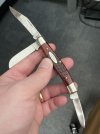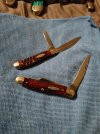- Joined
- Aug 7, 2003
- Messages
- 470
I have searched, but can't find a good answer for my question.
In my youth, my first knife, and that of many of my friends, was a Case Stockman in kind of a brownish jigged bone with the oval shield similar to what now comes on the yellow delrin models.
Many of our parents carried the same.
What was the color of that bone called? And it seemed to be the standard offering for many years, why do they no longer do them that way?
In my youth, my first knife, and that of many of my friends, was a Case Stockman in kind of a brownish jigged bone with the oval shield similar to what now comes on the yellow delrin models.
Many of our parents carried the same.
What was the color of that bone called? And it seemed to be the standard offering for many years, why do they no longer do them that way?



